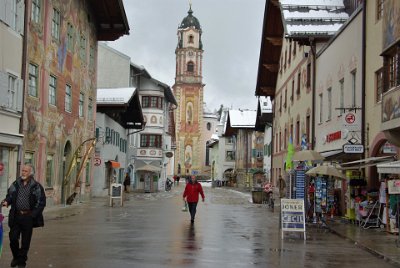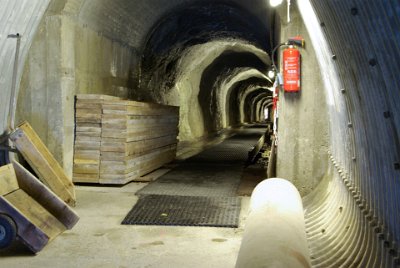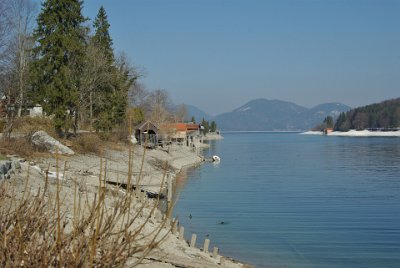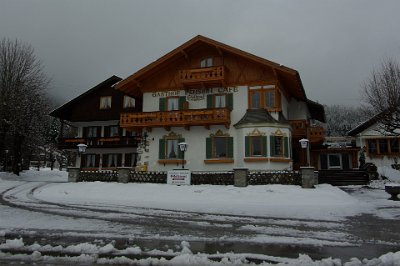 1 Sunday 20 June, 2010 Our Bavarian adventure begins in earnest today. We travel 57 kms to Mittenwald very near the Austrian border via a narrow toll road that runs beside the Isar as it flows northwards. Despite three other vastly more sensible routes, the TomTom chose this because it was shortest. This was a continuation of our many problems with the bloody thing. |
 2 Sunday 20 June, 2010 But first, before setting out, I confessed that my left eye had deteriorated badly. Then an amazing thing happened: Dani Barrett phoned Dr Franz Hoffman in Bad Tölz. It was Sunday, he was on holidays and he made a house call to our guest house. He told me what to do next and refused payment. That is absolutely, bloody amazing. And my ankle was swollen and I had the shakes. Bugger. |
 3 Sunday 20 June, 2010 There was nary a sound of civilisation to be heard. Instead, our eardrums were tickled by the burble of the river as it flowed towards Bad Tölz and on to the Danube. The fog hanging over the Bavarian Alps added to the serenity of this magical place. At this very moment, I do not remember my ankle being sore at all. |
 4 Sunday 20 June, 2010 The route to Mittenwald takes us through a wilderness area that closely follows the Isar River. Because of the rains the river flows swiftly. |
 5 Sunday 20 June, 2010 This is the Rathaus in Mittenwald. It serves as a tourist office as well. |
 6 Sunday 20 June, 2010 It is now summer in Mittenwald. The trees are flourishing, the window boxes are flowering and the temperature is mild. This contrasts with . . . |
 7 Sunday 20 June, 2010 . . . last year when we were here in late winter. |
 8 Sunday 20 June, 2010 Mittenwald appears to have survived WWII without damage. The modern German Army has its Mountain and Winter Combat School located in Mittenwald - seems like a good place for it. |
 9 Sunday 20 June, 2010 We wander around for a while and enjoy the sights. |
 10 Sunday 20 June, 2010 We had a late start because of the doctor's visit and it is soon time for lunch. We go to the same restaurant that we went to last year with Bonnie, Dennis and Claus. |
 11 Sunday 20 June, 2010 It's time to visit Mittenwald's violin museum. The industry was started by Mathias Klotz in the 17th century and this monument bears his name. |
 12 Sunday 20 June, 2010 The Geigenbau Museum records Mittenwald's history of violin making - which continues to this day. A geigenbau is a violin and a geigenbauer is a violin maker |
 13 Sunday 20 June, 2010 Matthias Klotz was the first of a dynasty of 36 violin makers. He first began his craft in 1685. |
 14 Sunday 20 June, 2010 The construction of a violin requires many different types of wood. The body is made of spruce and maple, while the fingerboard, pegs and tailpiece are made of ebony or other rare hardwoods such as boxwood and rosewood. The wood may take as much as twenty years to season. |
 15 Sunday 20 June, 2010 This is a replica of a typical violin maker's workshop from a few centuries ago. |
 16 Sunday 20 June, 2010 Over three centuries of violin makers were based in, or learned their craft in, Mittenwald. |
 17 Sunday 20 June, 2010 This display illustrates the steps required to make a violin. Only animal glues such as bone and skin glue are used in its assembly. In the dry, cured state these glues are considerably harder and less elastic than modern PVC glues and absorb less vibration. Despite their stregth, they can later be steamed open for repair. When the violin is complete, it may take several months before the instrument is tuned to the craftsman's satisfaction. |
 18 Sunday 20 June, 2010 In order to make a top-class instrument, complex adjustments are necessary: • The violin-maker plays the new instrument for a few weeks & notes the sounds that are too weak, strong, dull or shrill. • If he discovers a fault, he opens the violin and begins to scrape away thin layers of wood in certain places, • after which he glues the violin back together and revarnishes it. (Even the varnish affects the quality of the sound). He then repeats this process until the instrument is perfect. Top prices are paid for instruments like these. |
 19 Sunday 20 June, 2010 This is a musical notation system called the neume that was the basic element of Western and Eastern systems prior to the invention of the modern five-line staff notation. The three diamonds at the start of each line represent the F Clef. The notes are called points and they can exist as a single note or, when joined by lines, as ascending or descending notes. |
 20 Sunday 20 June, 2010 This video presentation was interesting. It described the three-year course required to become a violin maker. The course includes the study of music in addition to the craft itself. It also described Mittenwald's historic place in the world of violin making. |
 21 Sunday 20 June, 2010 This is a collection of rare violins, violas and cellos kept in atmospherically-controlled glass cases. |
 22 Sunday 20 June, 2010 Mathias Klotz´s son Sebastian had a huge stylistic influence on the Mittenwald "school" of violin making: his personal violin model became the shining example for other violin makers. |
 23 Sunday 20 June, 2010 There was a later, second school of violin making that developed parallel to the Klotz school based on the work and influence of Matthias Hornsteiner (1760–1803). Through the influence of these two schools, Mittenwald violin making reached its first peak of success in the second half of the 18th century. |
 24 Sunday 20 June, 2010 As a result of wars, fires, natural catastrophes and economic lows in Europe in the late 18th and early 19th centuries, Mittenwald suffered a number of setbacks. |
 25 Sunday 20 June, 2010 The Napoleonic Wars, and in particular the Russian Campaign of 1812, had a disastrous effect on violin making in this area. Of the ninety violin makers registered in 1811, only twenty five survived. |
 26 Sunday 20 June, 2010 Also during the early 19th century, retailers took over control over violin making in Mittenwald. They established and controlled the prices and dictated what would be made and how. Since the most lucrative market was for inexpensive, simply made instruments, there was a decline in the quality of the instruments. |
 27 Sunday 20 June, 2010 As a result of dealer hegemony, violin making became a piecework trade in which individuals specialised in doing one step of the process. By the middle of the 19th century, the division of labour was so extreme that there were very few in Mittenwald who could still make an instrument from start to finish. |
 28 Sunday 20 June, 2010 The ravages of WWI and the resulting economic crisis that followed ended violin making in Mittenwald. It was not until demand swung back to high quality, individually made instruments that violin making began to revive. |
 29 Sunday 20 June, 2010 After WWII a number of violin makers displaced from Czechoslovakia settled in Mittenwald and contributed to the revival of quality violin making in Mittenwald. Today in Mittenwald there are eleven local workshops in which plucked or bowed stringed instruments are made. |
 30 Sunday 20 June, 2010 This visit was vastly more interesting than museums filled with stuffed animals, or bits of pottery, or clothes worn by royalty, or ancient weapons of war, or bones and skulls. In front of us is the Catholic parish of St. Peter and Paul Mittenwald. |
 31 Sunday 20 June, 2010 The church was built in 1734. Matthäus Günther, a famous Bavarian artist of the 18th century painted a frescoe of the church’s patrons, Sts. Peter and Paul, on the dome inside the church while his students painted the exterior of the tower. This is a photo I took last year because I had brain-fade this year. |
 32 Sunday 20 June, 2010 I took this picture inside the museum of a photo from the early 1900's. The church has not changed, the Statue of Mathias Klotz is still there but the surrounding buildings have changed markedly. |
 33 Sunday 20 June, 2010 I asked Rolf (whom we meet later) why the rocks are on the roofs in some places. He said it was to do with reparations from France after the 1870 Franco-Prussian war. I still do not understand. |
 34 Sunday 20 June, 2010 OK, but why isn't it in his bedroom? |
 35 Sunday 20 June, 2010 Last year, we did not want to do the cable car ride to Karwendel because it was snowing. This time it was raining and Karwendel was covered in cloud but we thought "Bugger it, let's do it". |
 36 Sunday 20 June, 2010 We take the cable car to Karwendel. It takes 10 minutes and cost only €23 for the both of us. That is half price. |
 37 Sunday 20 June, 2010 The peaks of these mountains form the German-Austrian border. |
 38 Sunday 20 June, 2010 We go up into the clouds and I am thinking that maybe there will be blue sky when we get through them. |
 39 Sunday 20 June, 2010 The road beneath us is Highway 2 and it connects with Scharnitz in Austria, through a pass in the Alps, about 4 kms away. The Alps around Scharnitz is the source of the Isar River. |
 40 Sunday 20 June, 2010 As we rise, we enter the rain clouds. Very exciting. The German Army base is at the far right of the picture. |
 41 Sunday 20 June, 2010 Snow. There is snow on the trees. This cannot be right, it is summer! |
 42 Sunday 20 June, 2010 Halfway up, we pass the other car coming down. We are completely hidden in the clouds. |
 43 Sunday 20 June, 2010 When we get to the top, we see snow everywhere and no blue sky. |
 44 Sunday 20 June, 2010 The restaurant is covered in snow and open for hot drinks only. |
 45 Sunday 20 June, 2010 This graphic at the Bergstation tells us that we are at a height of 2,240 metres or 7,300 feet, about the height of Australia's tallest peak. Karwendlespitze (peak) is 2385 metres. |
 46 Sunday 20 June, 2010 Jenni takes a movie of the snow. |
 47 Sunday 20 June, 2010 Brilliant white because the snow is very fresh. We cannot believe that the snow is so thick. |
 48 Sunday 20 June, 2010 This amazing scene is Karwendel in the middle of summer. It's actually snowing as we watch. |
 49 Sunday 20 June, 2010 This tunnel is 420 metres long and takes you to the other side of the mountain for more breath-taking views. We postpone this for another day. |
 50 Sunday 20 June, 2010 The round building is the Nature information center "Karwendel Alps". It extends 7 feet over the edge for interesting views of the surrounding Alps and, with my mild acrophobia, I had no desire to go into it. It was probably shut today anyway. |
 51 Sunday 20 June, 2010 We are in the cable car returning to Mittenwald. The velocity of 4.8 metres/second works out to be 17.3 Kph. Because of a curious mathematical quirk, it took exactly the same time to return as it did coming up: 10 minutes. |
 52 Sunday 20 June, 2010 We stand in the parking lot of the Karwendelbahn Valley Station, look back up and Karwendel is still covered in cloud. This was a fun experience. |
 53 Sunday 20 June, 2010 We return via the northern edge of the Walchensee. We had been along this route a couple of times last year and remembered it as being very beautiful. |
 54 Sunday 20 June, 2010 The Walchensee is one of the deepest and largest alpine lakes in Germany, with a maximum depth of 192.3 metres and an area of 16.4 square kilometres. 1 sq km = 1000m X 1000m = 100 hectares. |
 55 Sunday 20 June, 2010 The lake is 75 kilometres south of Munich in the Bavarian Alps. |
 56 Sunday 20 June, 2010 Walchensee fills a tectonic valley and the extreme depth of the lake of 192.3 metres is the result of this tectonic formation. |
 57 Sunday 20 June, 2010 The creation of the lake from the forces of mountain building indicate that Walchensee could be one of the oldest lakes in Germany. During the last ice age (which was at its maximum 26,500 to 19,000 years ago), the Isar-Loisach glacier repeatedly scoured the area. |
 58 Sunday 20 June, 2010 The water really is this colour. |
 59 Sunday 20 June, 2010 Jenni takes a photo of the canoes moored by the water's edge . . . |
 60 Sunday 20 June, 2010 . . . and this is the photo she took. |
 61 Sunday 20 June, 2010 Last year, it looked like this when we went with Claus, Bonnie and Dennis to Mittenwald . . . |
 62 Sunday 20 June, 2010 . . . and this is what it looked like a couple of days later when we returned from Innsbruck in Austria. The water level is much lower than today because they take water from the lake, only in winter, to drive a nearby hydro-electric power station. |
 63 Sunday 20 June, 2010 This is the Walchensee village, a popular destination for day trippers from Munich. The word "pension" has an interesting meaning in Germany. Pension still means retirement but it means a place that you retire to for rest. |
 64 Sunday 20 June, 2010 It was not so inviting last year in late winter though. Next stop: The bad newsFootnote: for dinner tonight we went to McDonald's in Bad Tölz and got a big surprise: the toilets were spotless, the floors were clean, paper towel was available and there were even candles on the spotlessly clean sinks. However, for the money we could have had a proper meal in a pub. |